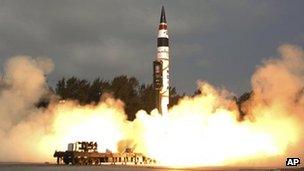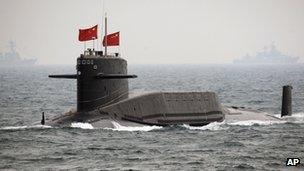Will India's missile test trigger arms race with China?
- Published

The new Indian missile will be capable of reaching most of China
India's test firing of an Agni-V ballistic missile this week is a potent signal of the country's growing nuclear capabilities.
The weapon - with a range of more than 5,000km (3,100 miles) is capable of delivering a nuclear warhead to the Chinese capital Beijing. The Agni-V is the latest in a series of Indian-developed missiles of varying ranges and capabilities.
It will become operational within about two years, adding significantly to India's nuclear punch.
So should China be worried? Probably not, according to US nuclear expert Taylor Fravel, an associate professor at the Massachusetts Institute of Technology.
"The missile has been under development for some time," he told me, "and is already factored into Chinese planning.
"The development of this missile does not undermine China's own deterrent capability," he says, "even though it may strengthen India's. China retains the ability to survive a first strike by India, however unlikely that may be."
Indeed, western experts have been quick to play down the significance of the Indian missile test, noting that the nuclear dynamics of the region are complicated and involve other countries, not just India and China.
Jeffrey Lewis, who heads the East Asia Non-proliferation Programme at the Center for Non-proliferation Studies in Monterey, California, puts it this way: "Beijing tends to focus much more on the United States, rather than India. Indian officials talk about China much more than their Chinese counterparts talk about them."
Indeed, he suspects that "New Delhi's emphasis on China is more about slighting Pakistan than competing with China."
China is already modernising its own nuclear-armed medium- and intermediate-range missile systems that could be used to target India. But as Taylor Fravel notes, "India and China have similar nuclear doctrines, as both emphasize no first use and achieving deterrence through development of a secure second-strike."
Expanding deterrents
It should be remembered that compared to Russia and the United States, China and India have relatively small nuclear arsenals. China is believed to have a stockpile of around 240 warheads, with perhaps 175 of them active.

The missile launch prompted much speculation as to whether the regional balance of power will change
In recent years it has been deploying more modern solid-fuelled missiles like the two-stage DF-5A with a true inter-continental range capable of threatening the United States. It deploys a number of shorter-range systems like the DF-21 - a potential threat to India.
China's modernisation of its nuclear deterrent includes the development of a small number of submarines capable of carrying ballistic missiles, but it is not yet judged to have an operational sea-going submarine-launched capability.
India, in contrast, is believed to have around 100 nuclear warheads, some capable of being dropped from aircraft. But the bulk of its nuclear punch rests upon short-range Prithvi missiles and medium-range variants of the Agni missile.
India, too, is seeking to take its nuclear deterrent to sea. It is building a new class of nuclear-powered submarines intended to carry ballistic missiles. The first of these Arihant-class boats has already been launched and is expected to enter service next year. Five more are planned.
However, Jeffrey Lewis suggests that it is wrong to see in the dynamics between Beijing and Delhi echoes of the Cold War arms race between the US and the Soviet Union.
"I doubt very much", he says, " that China and India will engage in an arms race, scaled-down or otherwise.
"Both countries," he argues, "tend to pursue the same specific capabilities, but neither produces large numbers of nuclear weapons or nuclear-capable missiles."
He suggests that both China and India seem to be pursuing what he calls a "possession" oriented approach to nuclear modernisation: "They are developing in turn small numbers of ever more advanced capabilities held by other powers.
"Neither country, however, has produced anywhere near the number of nuclear weapons or nuclear-capable missiles that each is capable of producing."
A growing threat - for whom?
According to Taylor Fravel, "the main strategic dynamic behind China's nuclear modernisation is the need to maintain a secure second-strike capability". In other words, the ability to launch a counter-attack if China is attacked with nuclear weapons.
"From China's perspective," he says, "the main threat to this capability comes from United States, which has been developing both ballistic missile defences that could prevent China from launching a counter-attack and long-range precision strike capabilities that could be used to attack China's nuclear forces (or command and control systems) with conventional and not nuclear weapons."

China's expansion of its sea-borne nuclear capability has worried some in other nations, notably the US
Indeed, it is in the United States that some of the most active debate is underway on the significance or otherwise of China's nuclear modernisation.
This comes against a backdrop of discussion about eventually reducing the US military arsenal further - below the 1,550 deployed warheads set by the most recent arms reduction agreement with Moscow. It should be noted that the US arsenal in 2010 stood at some 2,468 operational warheads according to the respected journal, The Bulletin of the Atomic Scientists.
Some in the US see China's modernisation plans - especially its move to develop a sea-going component for its nuclear deterrent - as indicative of a growing threat to the continental United States.
Critics of China point to a huge network of underground tunnels which some believe could be hiding a significant part of its nuclear arsenal.
Other analysts take a less dramatic view, arguing that everything we know about the Chinese deterrent suggests a more purposeful and slower pace of modernisation. These differences were on display when the House Armed Services Committee took evidence from various experts in October of last year.
What everyone could agree on was that a lack of transparency on the part of Beijing remains a serious problem in making any accurate assessment of China's nuclear trajectory.
- Published19 April 2012
- Published20 April 2012
- Published19 April 2012
- Published5 January 2012
- Published4 April 2012